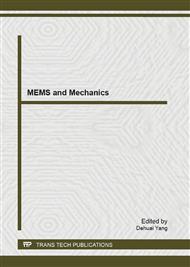[1]
Y.S. Kuo, "A study of Riser Feeding Behavior of High Strength A201 Aluminum Alloy," Ph. D. Thesis, NCKU, Tainan, Taiwan, ROC (1990)
Google Scholar
[2]
E.L. Rooy, Modern casting 32, Oct. 1992.
Google Scholar
[3]
S.D. Felicelli, E. Escoburde Obaldia, and C.M. Pita, "Simulation of Hydrogen Porosity During Solidification," AFS Transactions, Vol.115, pp.47-59, 2007.
Google Scholar
[4]
S.T. McClain, J.T. Berry, and B. Dawsey, "A Study of Porosity and Pore Morphology in Aluminum A356.2 Step Castings," AFS Transactions, Vol.111, pp.147-158, 2003.
Google Scholar
[5]
S.Poola, S. Felicelli, S. Leggett, and J.T. Berry, "A Reexamination of Factors Affecting porosity Gradients in Unidirectionally Solidified Samples," AFS Transactions, Vol.116, pp.157-168, 2008.
Google Scholar
[6]
F.M. St. John, W. Wu and J.T. Berry, "Effect of Thermal Parameter on Ductility of Aluminum Alloys," AFS Transactions, Vol.76, pp.645-654, 1968.
Google Scholar
[7]
Y.S. Kuo, "Mechanical Properties and Porosity Content of A201 Aluminum Alloy Castings in Different Cooling Rate Sand Molds," Advanced Materials Research, Vols. 154-155, pp.787-793, 2011.
DOI: 10.4028/www.scientific.net/amr.154-155.787
Google Scholar
[8]
C.Y. Lin, K.Murahami, and T.Okamoto, "Internal and External Shrinkages in Undirectionally Solidified Al-4.5wt.%Cu Alloy," Materials Science and Engineering , A108, pp.265-270, 1989.
DOI: 10.1016/0921-5093(89)90429-2
Google Scholar
[9]
G.V. Kutumba Rao and V. Panchanathan, "End Chills Influence on Solidification Soundness of Al-Cu-Si (LM4) Alloy Castings," AFS Trans., Vol.81, pp.110-114, 1973.
Google Scholar
[10]
S.D. Pathak and O. Prabhaker, "Phenomenological Analysis of Feeding in Aluminum Base Alloys," AFS Transactions Vol.92, pp.671-680, (1984)
Google Scholar
[11]
D.R. Irani and V. Kondic, "Casting and Mold Design Effects on Shrinkage, Porosity of Light Alloys," AFS Trans.Vol.77, pp.208-211, (1969)
Google Scholar
[12]
E. Niyama, T. Uchida, M. Morikawa, and Saito, "A Method of Shrinkage Prediction and Its Application to Steel casting Practice," J. of Japan Foundrymen's Society, Vol.54, No.8, pp.507-517, 1982.
Google Scholar
[13]
Y.W. Lee, E. Chang, and C.F. Chieu, "Modeling of Feeding Behavior of Solidifying Al-7Si-0.3Mg Alloy Plate Casting," Metall. Trans. B, Vol.21B, pp.715-722, 1990.
DOI: 10.1007/bf02654250
Google Scholar
[14]
J.T. Berry, "Effects of Solidification Conditions on Mechanical Behavior of Al Cast Alloys," AFS Trans. Vol. 78, pp.421-428, 1970.
Google Scholar
[15]
N.S. Mahadevan and M.R. Seshadri, "Dimensioning of Risers for Long Freezing Range Aluminum Alloys," AFS Cast Metals Research Journal, pp.77-82, June 1971.
Google Scholar


